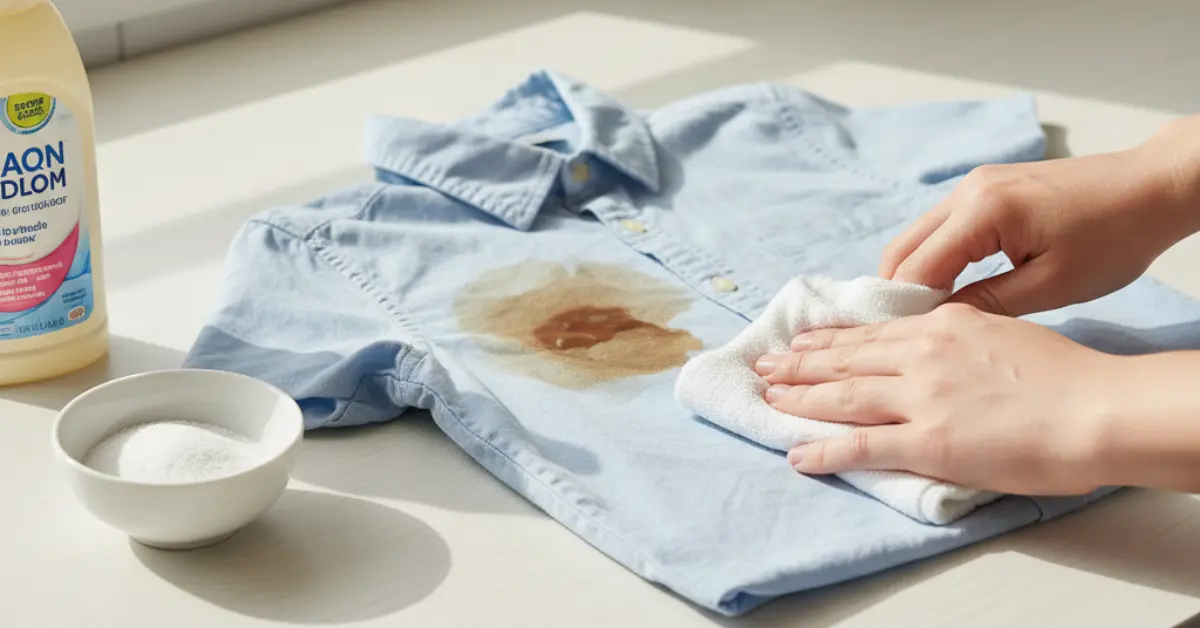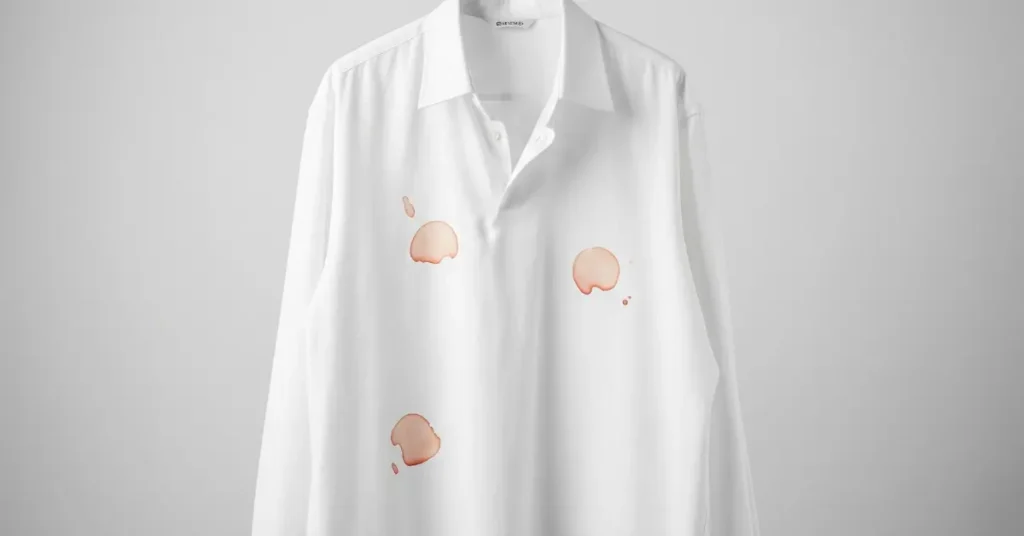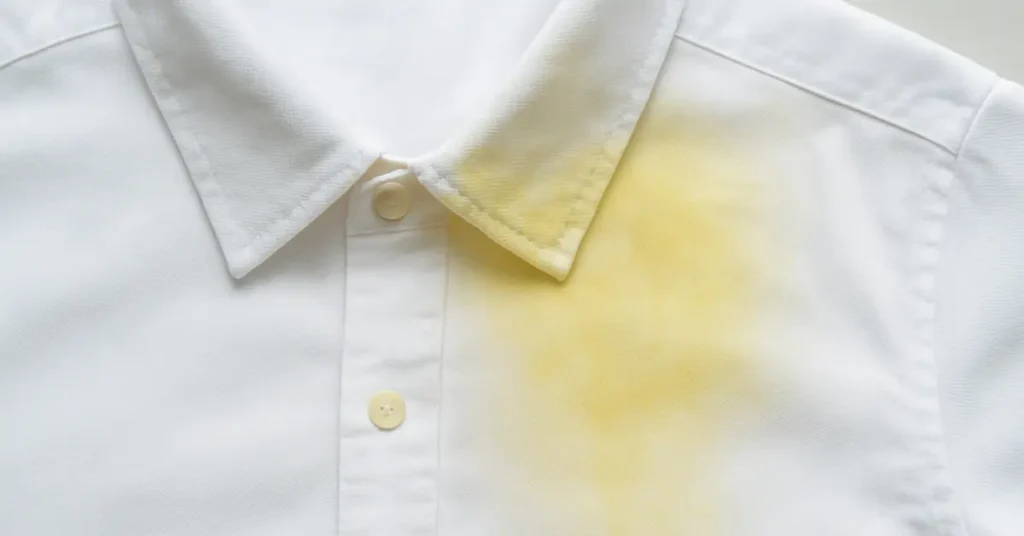Stains are part of everyday life. Sometimes it’s juice on kids’ clothes, coffee on mine, ketchup, chocolate, even grass stains—I’ve dealt with them all.
And I know how frustrating it feels when a favorite shirt looks ruined. Over time, I realized that most stains can be effectively treated if we act quickly and use the right method.
That’s what I want to share with you here: the simple tricks I use at home that really work.
General Tips for All Types of Stains
Some stains are naturally tough, while others only get tough if you don’t treat them the right way. From my experience, pre-treating is usually the key.
I usually start by gently scraping off any extra stain with a dull knife or spoon. Then I gently blot the stain with a damp cloth instead of rubbing it, because rubbing usually makes it worse.
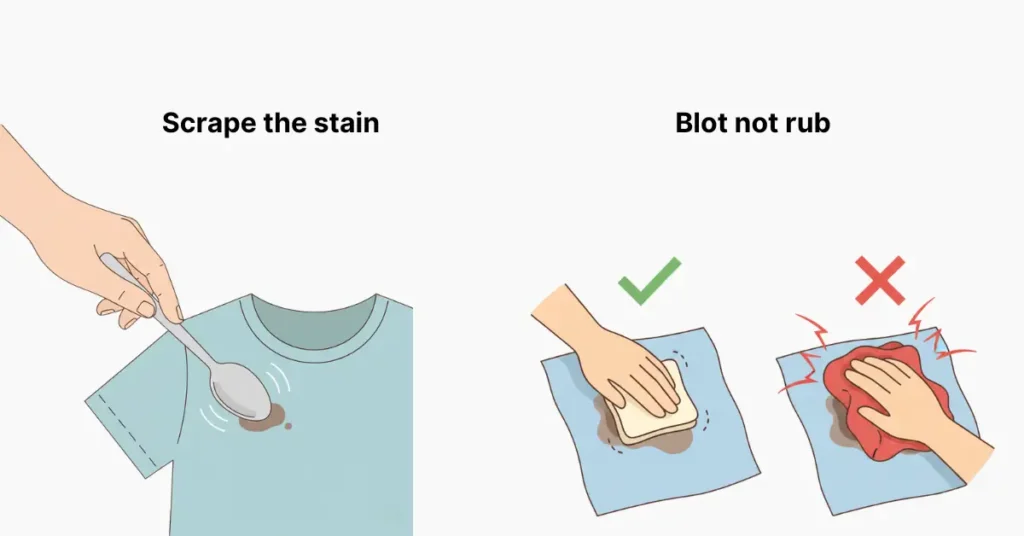
On most fabrics, a little enzyme-based detergent on the stain is usually sufficient. I leave it for a few minutes before washing, and then wash it as usual.
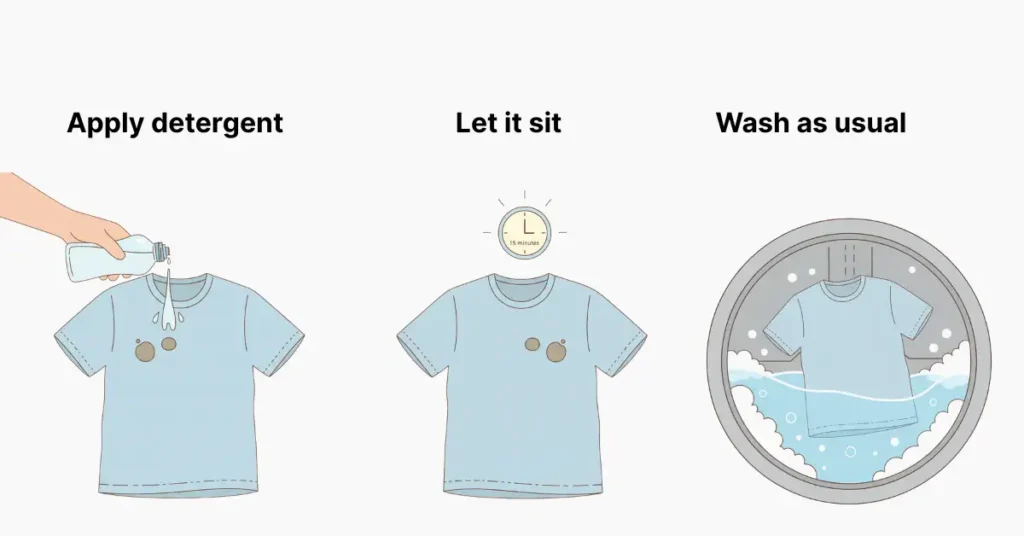
For delicate fabrics, like silk or fancy tops, I mix a small amount of detergent in cold water and press it lightly onto the stain without rubbing.
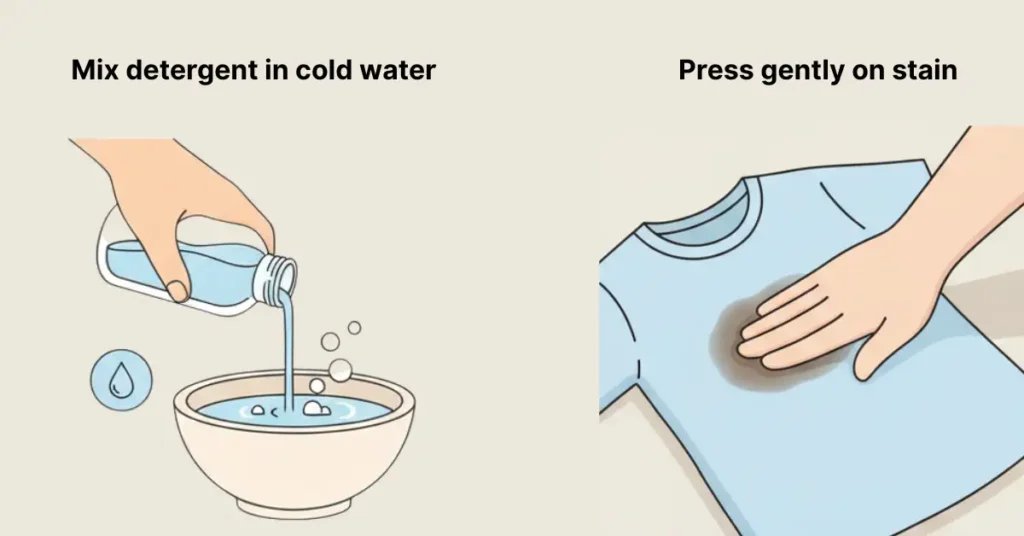
Old or stubborn stains are harder, but applying a bit of liquid detergent or stain remover before washing usually helps. I also always check the care label to make sure I use the right water temperature.
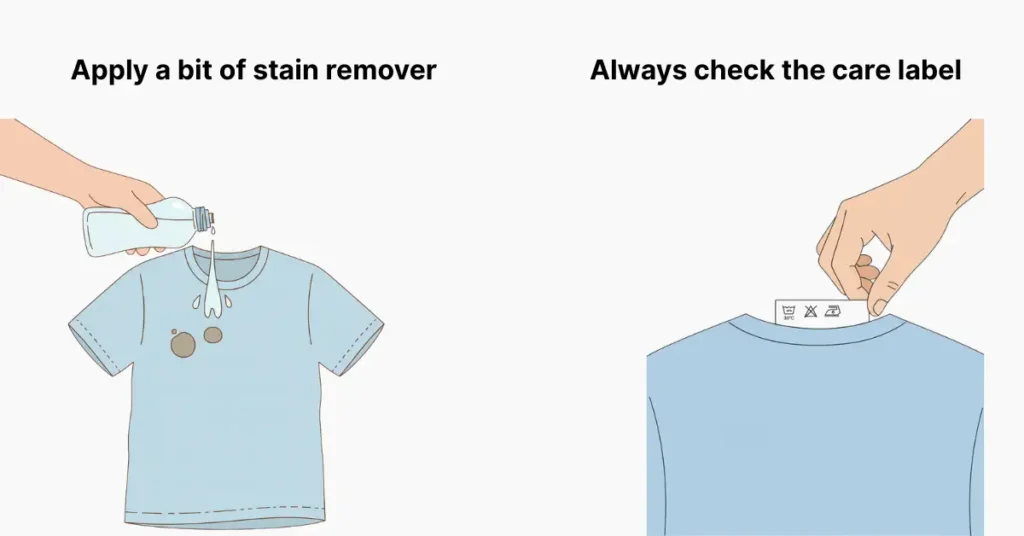
For white clothes, I usually use oxygen bleach on dark or stubborn stains. It helps lift them without harming the fabric. After washing, I always let the clothes air-dry instead of using the dryer, because heat can set any leftover stain.
Honestly, just doing these small things has saved me from so many laundry disasters. It doesn’t have to be stressful if you handle it quickly and carefully.
How to Remove Tough Stains
Almost all stains get tough if they dry, but even fresh stains can be tricky sometimes. Over the years, I’ve learned what actually works, and here’s what I do for different types of stains.
1. Coffee Stains
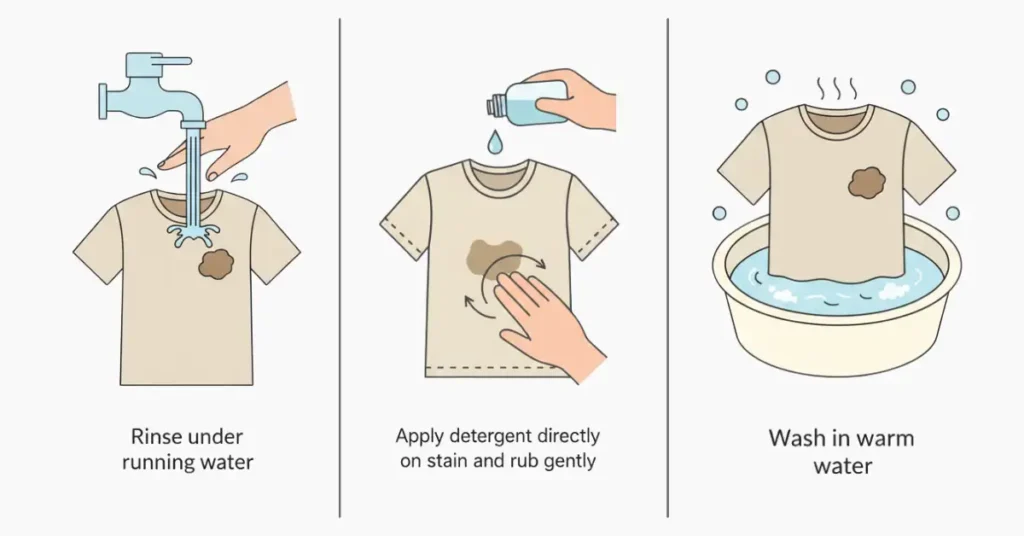
Coffee spills happen almost every morning. I usually run the stained area under running water right away to remove as much coffee as possible.
Then I put a small amount of enzyme detergent on the stain, leave it for a few minutes, and gently rub it with my fingers. After that, I wash it in warm water. If the stain doesn’t come out completely, I repeat the process.
2. Red Wine Stains
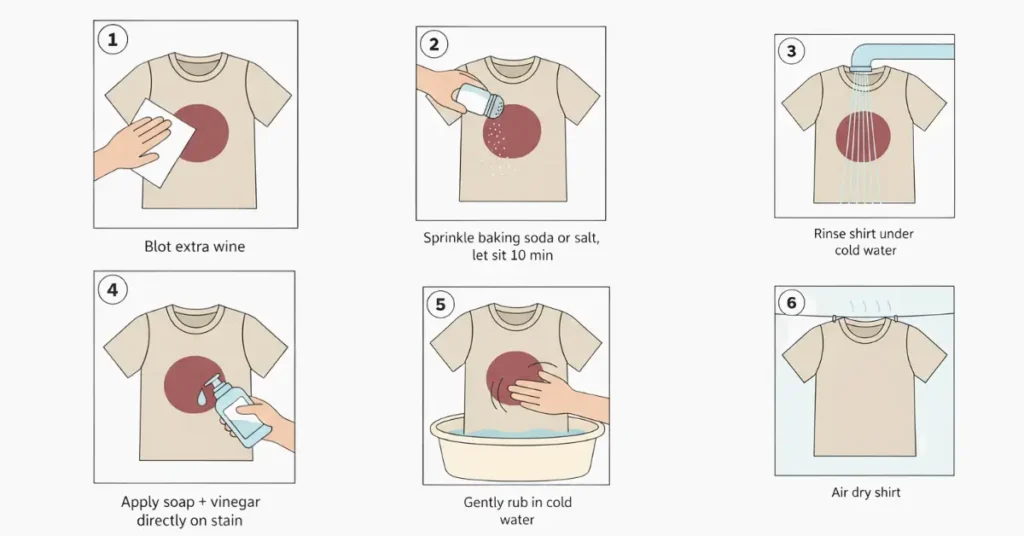
Red wine can feel impossible to remove, but this method works for me. First, I blot the extra wine with a paper towel, then sprinkle a little baking soda or salt on the stain and let it sit for about 10 minutes. These absorb the liquid.
After shaking off the powder, I rinse with cold water. If the stain remains, I mix equal parts dish soap and white vinegar, dab it on gently, and then hand-wash the fabric with mild detergent in cool water. I always let it air dry away from sunlight.
3. Tomato Sauce or Ketchup
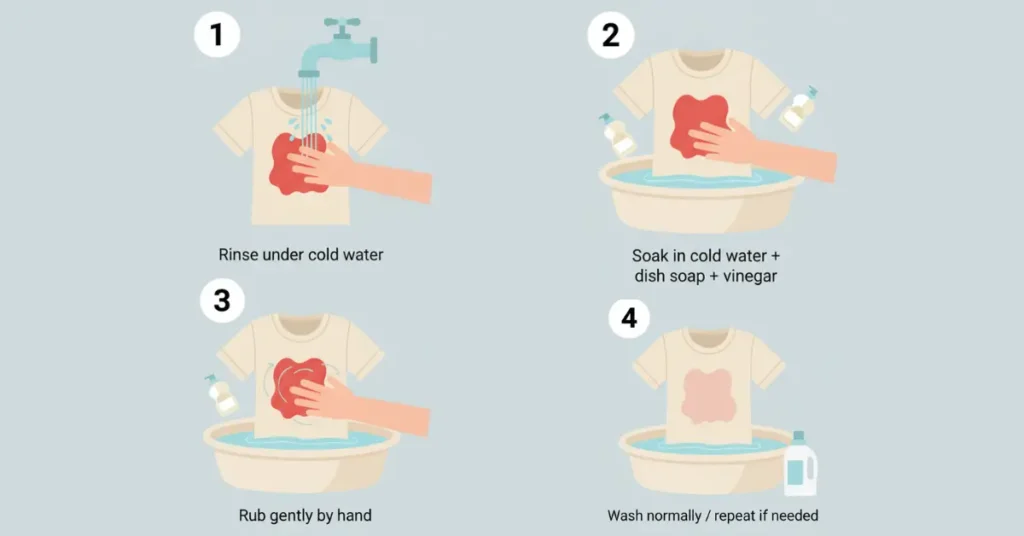
Tomato sauce and ketchup can be messy, especially with kids around. I rinse the stain under cold water first, then soak it in cold water mixed with a little dish soap and vinegar for at least 30 minutes.
I rub it gently by hand and then wash it as usual. If the stain is still visible, I repeat the process.
4. Grass Stains
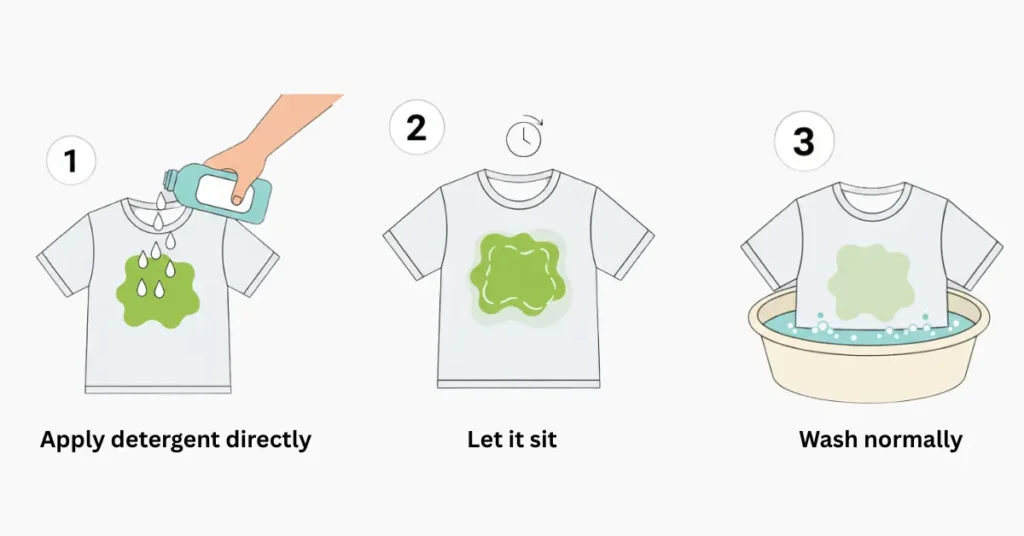
Grass stain is one of the toughest for me, but if you act fast, it comes out. I put some liquid detergent directly on the stain, leave it for a while, and then wash normally. For sportswear or delicate fabrics, I use enzyme-based detergents.
5. Nail Polish Stains
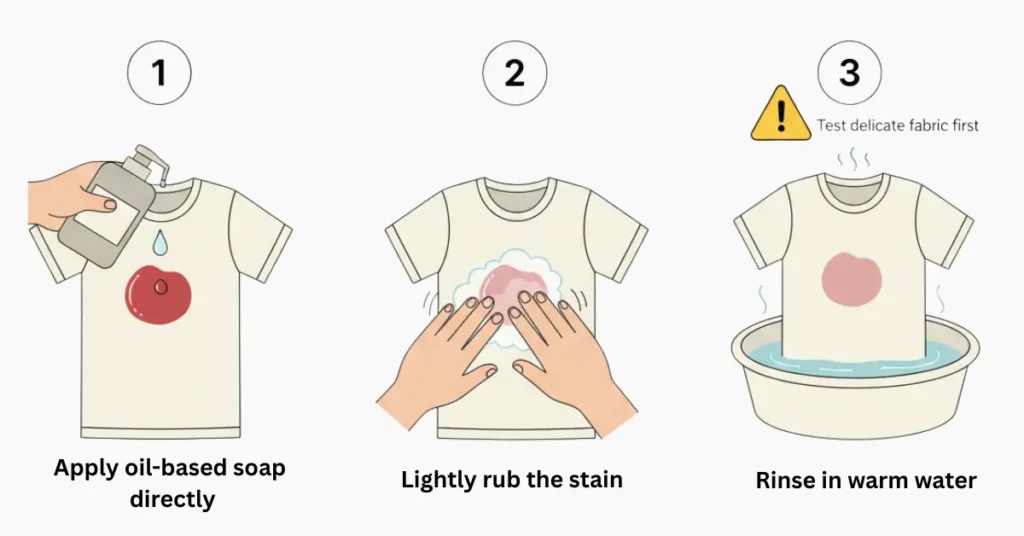
For nail polish, oil-based soaps work best. I apply a small amount on the stain, rub lightly, and wash with warm water. On delicate fabrics, I always test a small area first to make sure it won’t get damaged.
6. Ink Stains
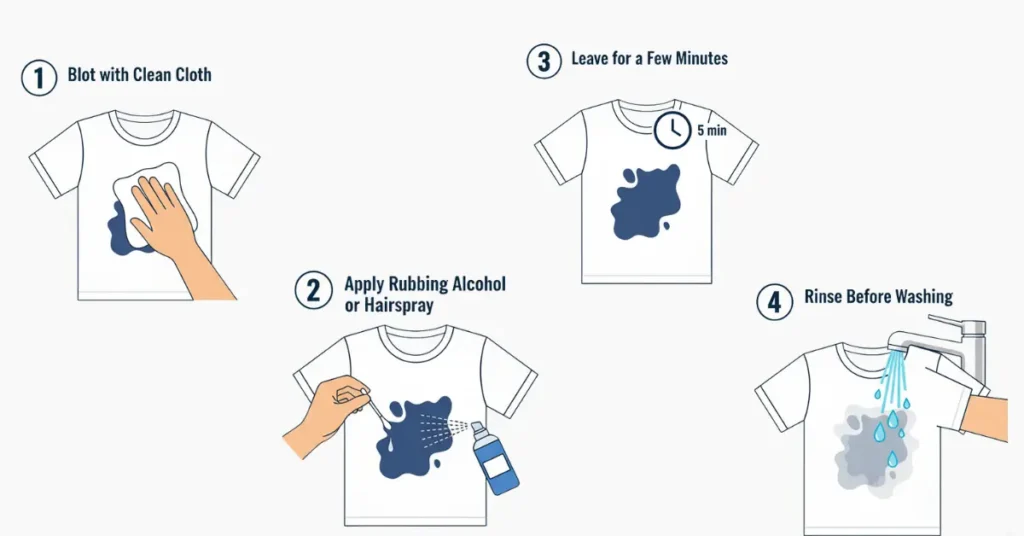
Ink can be tricky. I start by blotting with a clean cloth. Then I use rubbing alcohol or hairspray applied with a cotton swab, leave it for a few minutes, and rinse before washing. On delicate fabrics, I test a small area and dab gently.
Since ink stains can sometimes be stubborn and tricky to fully remove, I’ve shared a detailed guide on removing ink from clothes that shows the most effective methods step by step.
7. Sweat stains
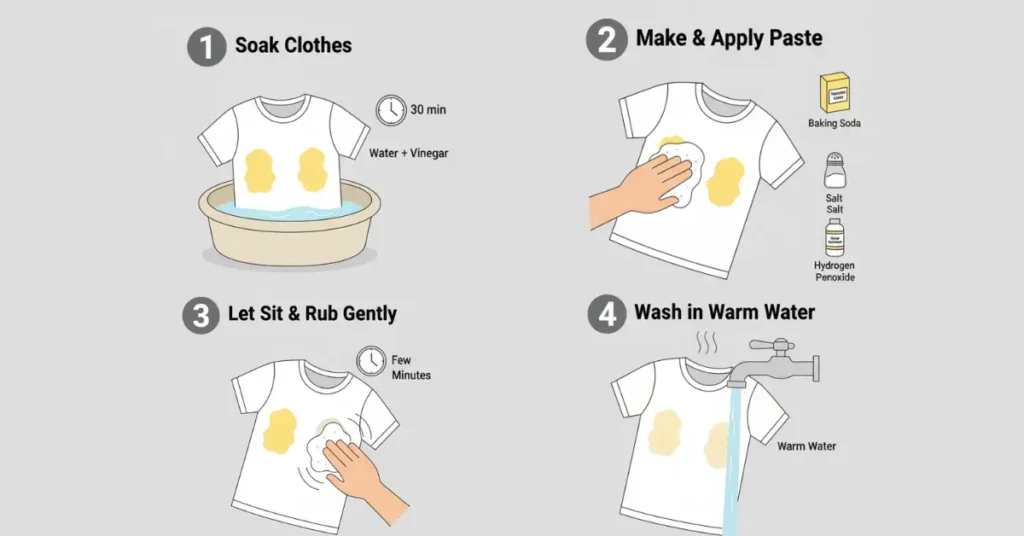
Sweat stains, especially yellow ones, need extra care. I soak the clothes in a mix of water and vinegar for about 30 minutes.
Then, I make a paste with baking soda, a little salt, and a bit of hydrogen peroxide. I apply it to the stain, leave it for a few minutes, rub gently, and then wash it in warm water. This usually removes even stubborn sweat marks. If you want to learn why yellow marks appear on your clothes and simple ways to stop them, check out this guide on preventing yellow stains on clothes.
8. Rust Stains
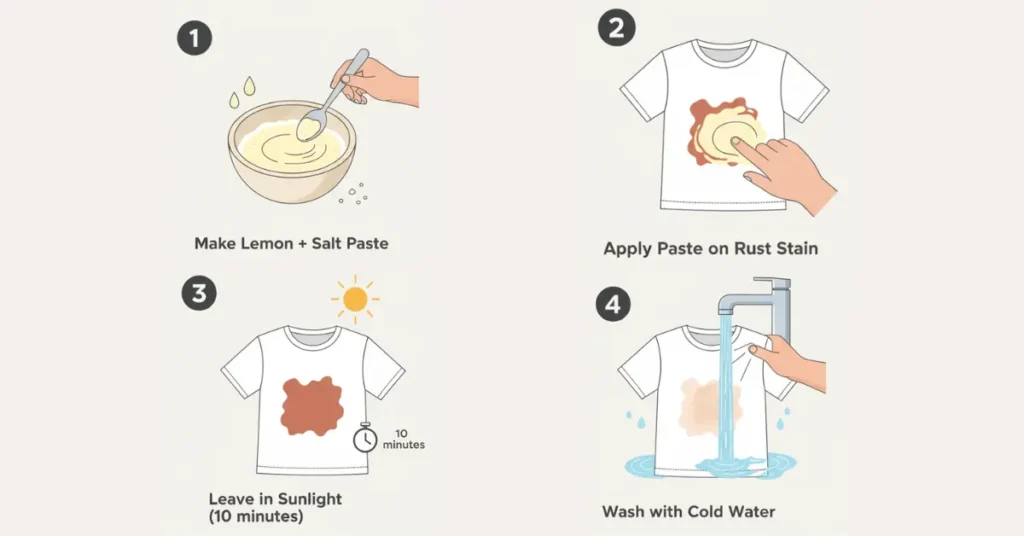
Rust stains respond well to natural solutions. I mix lemon juice with salt to make a paste, apply it to the stain, and leave it in the sunlight for about 10 minutes before washing with cold water. For every tough stain, a baking soda paste works too.
9. Blood stains
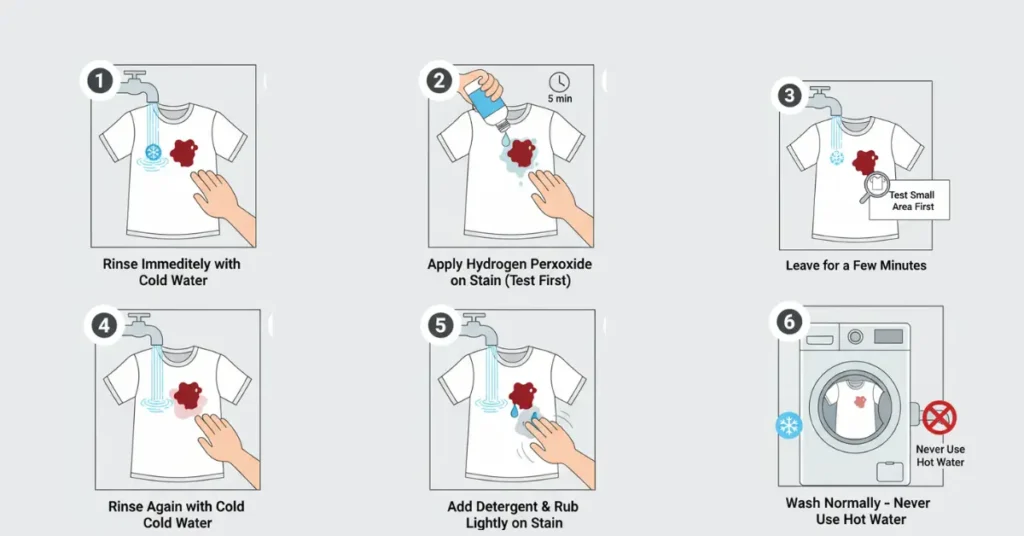
Blood stains should always be treated with cold water. I rinse immediately, apply a little hydrogen peroxide (testing a small area first), leave it for a few minutes, rinse, then add some detergent, rub lightly, and wash normally. Hot water will set the stain, so I never use it on blood.
10. Paint or Dye Stains
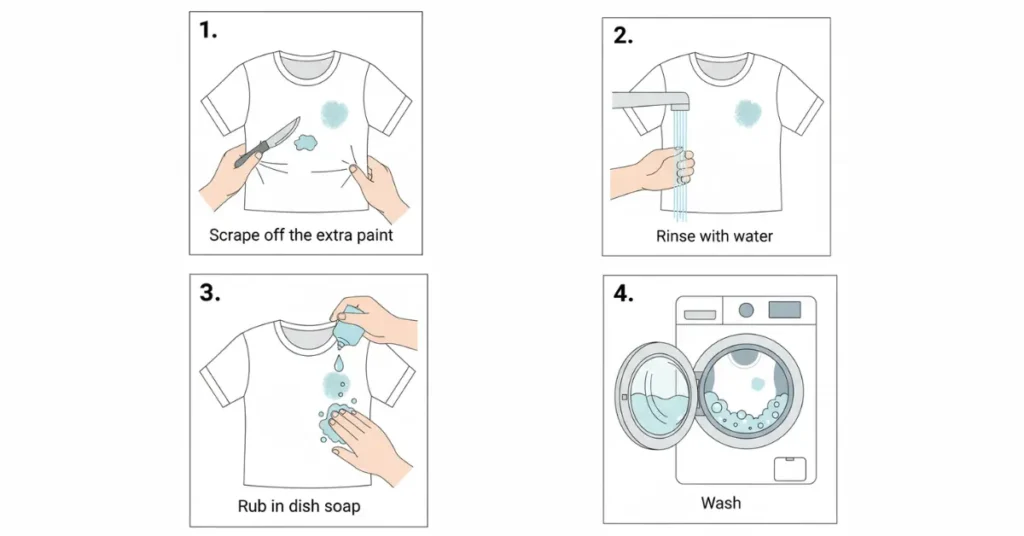
Paint is one of the toughest stains. If it’s fresh and water-based, I scrape off the extra, rinse with water, rub in dish soap, and wash.
For wet oil-based paint, I follow the manufacturer’s instructions using paint thinner on a paper towel, then wash. Dried paint may need rubbing alcohol or boiling water for latex paint, followed by washing with detergent.
11. Grease and Oil Stains
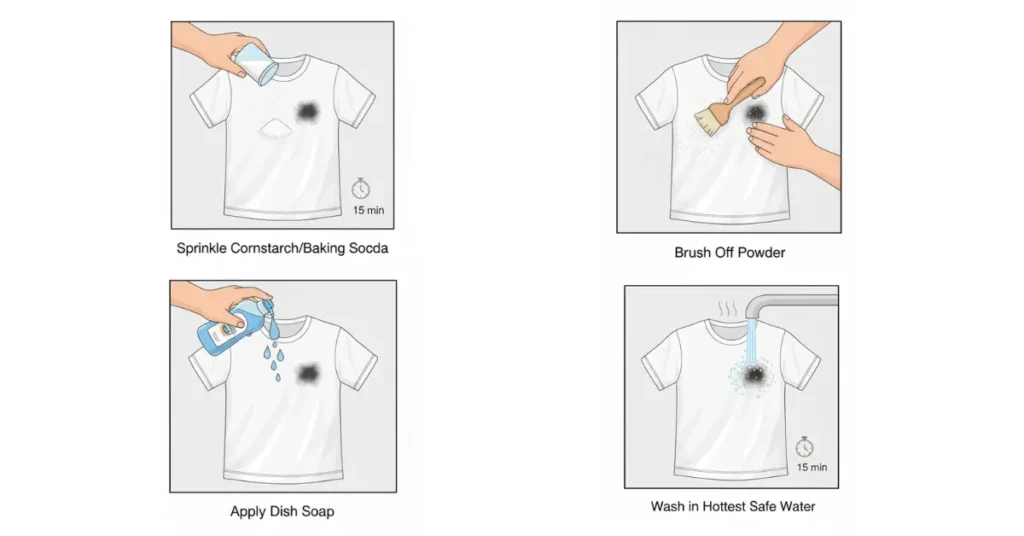
For grease or oil stains, I sprinkle cornstarch or baking soda on the stain to absorb excess oil. After about 15 minutes, I brush off the powder, apply dish soap to the area, and wash in the hottest water safe for the fabric. I avoid fabric softeners because they trap grease.
12. Chocolate stains
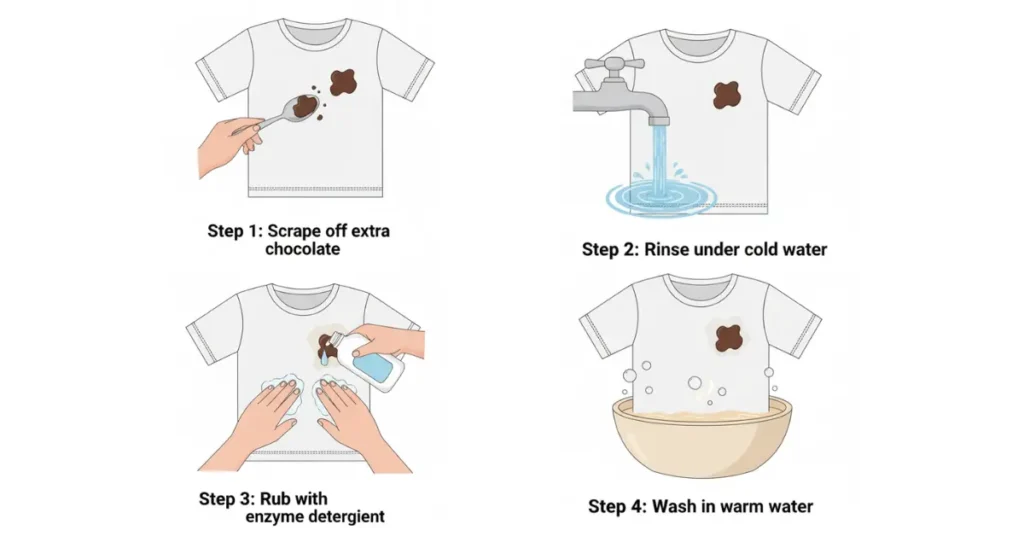
Chocolate is messy but manageable. I scrape off any extra chocolate with a spoon, rinse under cold water, rub with enzyme detergent, and wash in warm water. If the stain is still there, I repeat. On delicate fabrics, I blot gently instead of rubbing.
13. Berry Juice Stains
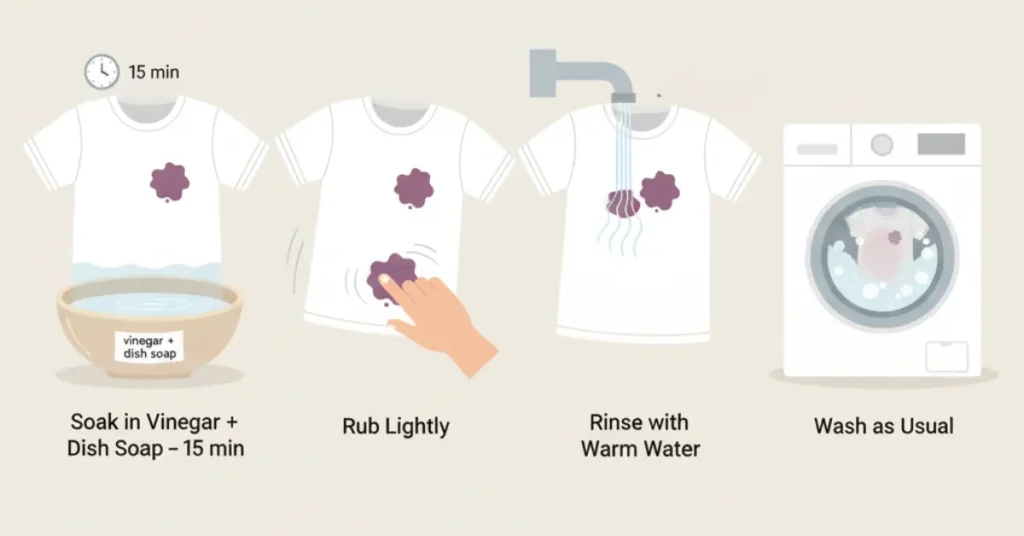
Berry juice can leave bright stains. I soak the fabric in a mixture of vinegar and dish soap for 15 minutes, rub lightly, rinse with warm water, and wash as usual. For white clothes, oxygen bleach helps remove deep stains. But honestly, white fabrics need a little extra care, so I’ve shared some simple laundry tips for white clothing that actually work.
14. Make-up stains
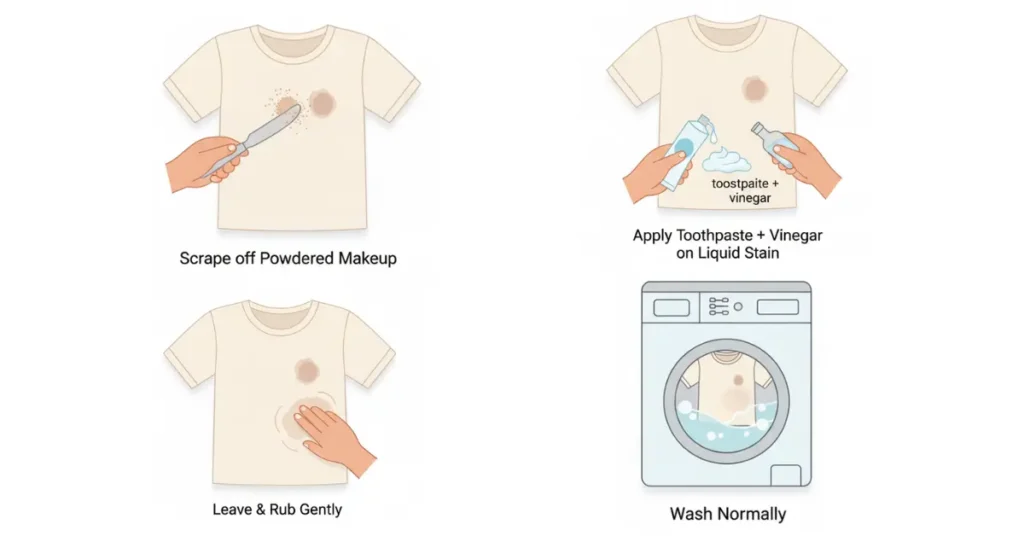
For powdered make, I scrape off the extra. For liquid makeup, I mix a little toothpaste with white vinegar, leave it for a few minutes, rub gently, and wash. On delicate fabrics like silk, mild baby shampoo works well.
After treating any of these stains, I wash the clothes with regular detergent as usual.
Tough Stains and How to Care for Your Clothes
| Stain | Fabric | Precautions | Recommended Method |
|---|---|---|---|
| Coffee | Cotton shirts, Polyester blends | Don’t rub / Avoid hot water for polyester | Blot with cold water, apply liquid detergent (for cotton) or dish soap + vinegar (for polyester), rinse appropriately, wash warm or lukewarm. |
| Red Wine | Cotton tops/napkins, Polyester blends | Cotton T-shirts, Polyester aprons/shirts | Soak cotton in a baking soda solution, wash warm. For polyester, apply liquid detergent, rinse lukewarm. |
| Tea | Don’t let it dry / Avoid hot water for cotton | Avoid bleach / Don’t scrub | Sprinkle salt or baking soda, rinse cold. For cotton, soak in a vinegar solution, wash with oxygen bleach. |
| Tomato Sauce / Ketchup | Apply dish soap (denim), baking soda paste (cotton), cornstarch or talcum powder (polyester), and wash accordingly. | Don’t rub / Avoid chlorine bleach | Scrape excess, treat with dish soap + vinegar, wash warm. Pre-treat polyester with dish soap before washing. |
| Grease & Oil | Cotton dress shirts, Silk ties/shirts, Denim jeans | Denim jeans, Cotton knits clothes, Polyester shirts | Avoid hot water first / skip fabric softener / Don’t scrub hard |
| Ink | Cotton T-shirts, Silk pillowcases/shirts | Don’t rub / Test small area / Avoid bleach | Dab cotton with rubbing alcohol, silk with diltuted vinegar or lemon juice, denim with rubbing alcohol or hairspray; then wash. |
| Sweat (yellow marks) | Cotton undershirts, Polyester gym wear | Avoid bleach / Don’t use hot water | Soak cotton in vinegar + baking soda paste, wash warm. Pre-treat polyester with enzyme detergent, wash cold. |
| Make-up | Cotton kids’ clothes, Polyester pajamas/shirts | Don’t rub / Be gentle | Apply shaving cream or dish soap on cotton, rinse, and wash. Use mild baby shampoo and a cold rinse for silk. |
| Grass | Denim jeans, Polyester sportswear | Avoid hot water / Don’t scrub too hard | Rub with vinegar or rubbing alcohol (denim), enzyme stain remover for polyester, and wash appropriately. |
| Blood | Cotton bedsheets / Clothes, Polyester shirts | Never use hot water / Avoid bleach | Dab cotton with rubbing alcohol, silk with diluted vinegar or lemon juice, denim with rubbing alcohol or hairspray; then wash. |
| Chocolate | Cotton kids’ clothes, Polyester pajamas/shirts | Don’t rub / Avoid bleach | Soak cotton in lemon juice or vinegar, and wash with oxygen bleach. Dab linen with club soda, wash normally. |
| Berry Stains | White cotton dresses, Linen tops | Avoid hot water / Don’t delay | Apply lemon + salt paste (cotton), rinse, and wash. Use fabric-safe rust remover for linen. |
| Rust | Cotton work shirts, Linen clothes | Don’t use bleach / Avoid scrubbing | Don’t let it dry / Avoid harsh chemicals |
| Paint / Dye | Cotton T-shirts, Polyester dresses | Don’t let dry / Avoid harsh chemicals | Rinse cotton in cold water, apply hydrogen peroxide, and wash. Soak polyester in salt water, then wash. |
Conclusion
Most stains can be removed if you act quickly and use the right method for the fabric. The longer you wait, the harder the stain becomes to clean.
So instead of panicking when a spill happens, just treat it right away and follow the right steps for that type of stain. A little care can save your favorite clothes.
FAQs
Can vinegar remove tough stains from clothes?
Yes. White vinegar works really well on many stains. It helps break down tough marks and is safe for most fabrics.
Does hydrogen peroxide get stains out?
Yes. Hydrogen peroxide acts like a natural bleach. It can lift stains such as blood, sweat, wine, and coffee. Always spot test first, especially on colored fabrics.
How long should I soak clothes in vinegar to remove stains?
It depends on the stain, but usually 15 to 30 minutes is enough. For tougher stains, you may need to repeat the process.
What is the best homemade stain remover for laundry?
A simple paste of 1 part baking soda, 1 part dish soap, and 2 parts hydrogen peroxide works really well. Apply it directly to the stain before washing.
Does Dawn dish soap take stains out of clothes?
Down is especially good for greasy or oily stains, but it also works on many food stains.
